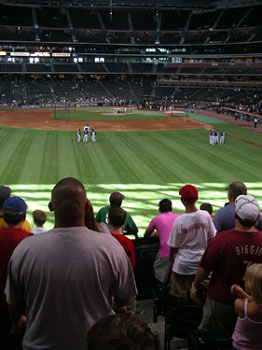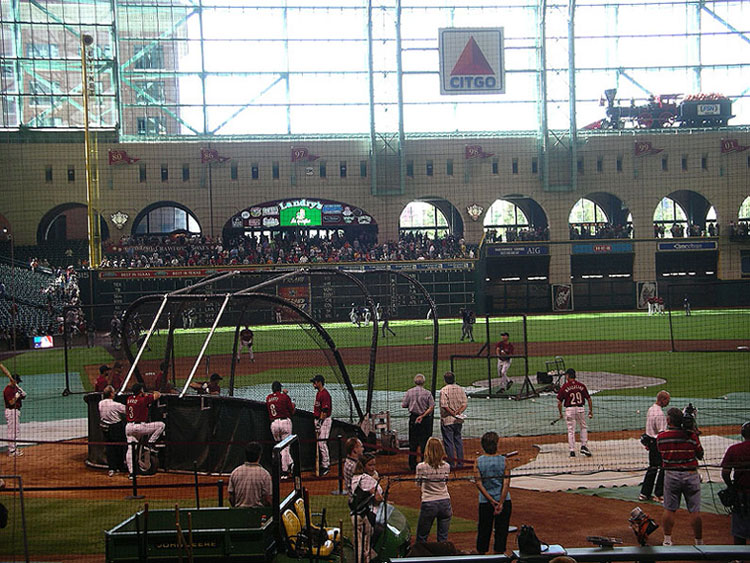
|
 For the majority of fans attending a baseball game, their afternoon or evening of entertainment begins shortly after the umpire yells “Play Ball” and the first pitch is thrown.
For the majority of fans attending a baseball game, their afternoon or evening of entertainment begins shortly after the umpire yells “Play Ball” and the first pitch is thrown.
Aside from a ceremonial first pitch and the singing of the national anthem, casual fans probably aren’t aware of the amount of activity that takes place in the ballpark before their arrival. But for the diehard baseball fan, the first pitch occurs a couple of hours after they have entered the ballpark. These fans arrive when the gates open to experience the time-honored tradition known as batting practice. Batting practice - often simply referred to as BP - is the domain of the serious fan seeking to acquire two things: an autograph or ball. To aid in their quest, these fans bring pen and glove in hopes of taking home a souvenir. If successful, the memories will last a lifetime and memories, after all, are the backbone of our national pastime. Thanks to the abundance of autograph shows and numerous pre-game opportunities, getting a player’s signature is an experience shared by many fans. But getting a baseball – an official Rawlings baseball with the Major League logo and commissioner’s signature – is perhaps the most prized souvenir in sport and much harder to obtain. Although the average life of a Major League baseball is only six pitches, the size of the ballpark and competition from 30,000 fans makes the likelihood of catching a foul ball very remote. I’ve been to a couple hundred ballgames in my lifetime and I've never caught a foul ball at any level of baseball. But I haven’t been completely shut out, and my bounty of balls stands at two. The first ball came from a minor league game: a home run hit by Brady Clark in Chattanooga at Engel Stadium on August 10, 1998. I happened to be standing in left field when Clark, now starring for the Milwaukee Brewers, hit the ball my way. Afterwards, I had him sign and date the ball and it remains one of my most prized possessions. Three years later, on June 23, I snared a ball at Tropicana Field before a Devil Rays game on a rare occurrence when I arrived early enough for BP. For most fans, batting practice is the only chance to get a ball as two important factors work in their favor: sparse attendance and the tendency of players to successfully swing for the fences. Although fans pile into the left and right field bleachers, it’s rare when they total more than a couple of hundred. After a few years of showing up in the vicinity of the first pitch I decided that it was time to make an active effort to add to my ball count. Having attended almost every Major League ballpark, I picked Houston’s Minute Maid Park as the destination where I best envisioned success. The Astros’ ballpark is a notorious hitter-friendly bandbox, and the Home Run Alley and Crawford Boxes section in left field – just 315 feet from home plate - are ideal places for baseballs to land during batting practice. For the first time in over 15 years I brought my glove and when the gates opened two hours beforehand I entered the ballpark with a few hundred other early arrivals, most of who had been lined up well before I got there. For the players, batting practice is an important part of their pre-game preparation and a strict routine is usually adhered to. The home team hits first, for an hour, and the visitors follow for 40 minutes. Usually the home team is finishing up shortly after the gates open, so fans can only watch the full batting practice of the away team. As for the actual process, a coach standing in front of the mound throws 60- to 70-mph fastballs to players in a portable batting cage. Players take turns hitting in four groups of three or four, and the first batter in the cage for each group is designated the group leader. The leader’s job is to determine how many swings the hitters receive each round. Many hitters work on something specific during BP, like hitting to the opposite field, but home runs fly into the stands with regularity, especially with power hitters in the batter’s box. Many of them like to see how far they can hit the ball, and two years ago Frank Thomas briefly used an aluminum bat in batting practice just for kicks. With balls landing in relatively empty seats the likelihood of catching – or at least retrieving – one would seem simple. The task seems even easier since players and coaches frequently toss balls into the stands for fans that ask for one. For some people getting a ball is as easy as buying a ticket. Zack Hample, a baseball fan in New York, has spent so much time at ballparks, and specifically batting practice, that he wrote a book about the subject. How to Snag Major League Baseballs: More Than 100 Tested Tips That Really Work was published by Simon & Schuster in March of 1999. Zack knows something about snagging a baseball or few. In 2004, he snagged a staggering 300 balls in just 37 Major League games, acquiring all but 10 during batting practice. In a 15-year period, Hample has amassed over 2,500 balls, which includes an amazing 86 foul balls hit during the game. So what’s the secret to Hample’s astonishing success? As he stated on his website: “I started wearing hats of all the visiting teams to look like a fan. I learned how to ask for baseballs in Spanish. I invented a contraption with my glove that enabled me to lower it with a string and collect balls that had previously been out of reach. I studied the way balls trickled down the steps and seats of empty sections. I positioned myself differently for righty and lefty batters. I learned how to outsmart stadium security and sit in any section I wanted.” So apparently there is a lot of work and science required. More effort than I, or just about any other fan, would care to spend. Mainly depending on luck and hopeful positioning in Houston, I was shut out. A couple of balls did crash off the wall above the Crawford Boxes and ricochet in my vicinity, but nothing really to get the heart racing. But thanks to Hample’s “research” I still have hope, if interested, as he determined that Turner Field is the easiest ballpark to get a ball during batting practice. Since I live near Atlanta, only 20 miles away from the ballpark, I have countless opportunities in the future without having to incur any travel expenses. All teams open the gates at different times prior to the first pitch, and at two-and-a-half hours the Braves are one of five teams that open their ballpark the earliest. In Houston the Astros normally open the gates to Minute Maid Park just 1.5 hours prior to game time. The exceptions are Friday and Saturday, when gates open two hours prior to first pitch. So a big reason for better batting practice success in Atlanta is because Turner Field opens to the public so early. That said, I don’t plan on showing up to The Ted early any time soon. The way I see it, even getting a ball during batting practice is like winning the lottery and with Hample’s book out of print I’d consider myself out of luck.
|


